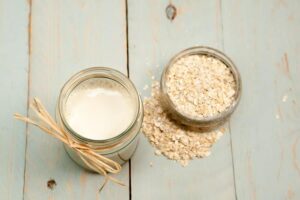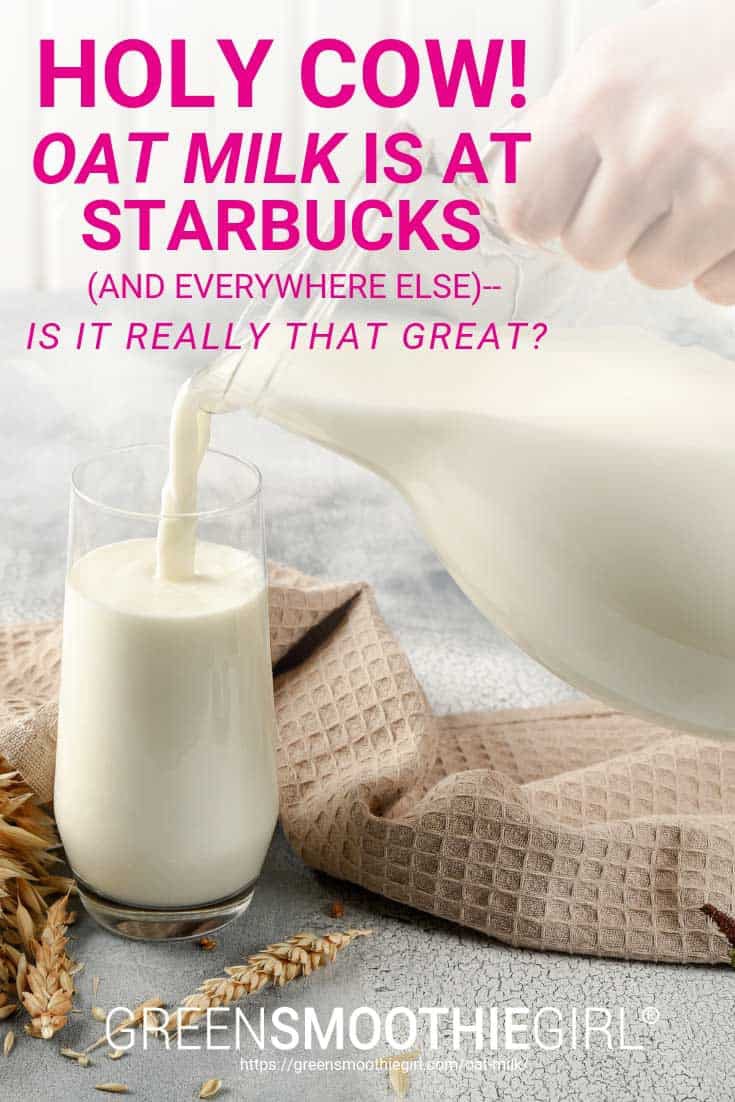Holy Cow! Oat Milk Is At Starbucks (And Everywhere Else)–Is It Really That Great?

Oat milk is the new kid on the block of dairy milk alternatives, created in Sweden in the 1990s and slowly gaining followers. Obsession didn’t set in until 2018 when some coffee shops started offering oat milk exclusively. Baristas now suggest it while vegans and environmentalists praise it. Why?
In this post:
- What is Oat Milk?
- What Does Oat Milk Taste Like?
- Health Benefits of Oat Milk
- Where Oat Milk Falls Short
- Oat Milk Is “Green”
- Homemade Oat Milk vs. Store Bought
- How To Choose A Good Store-Bought Oat Milk
- How To Make Homemade Oat Milk
- How To Use Oat Milk
- Conclusions About Oat Milk
Let’s look at what oat milk is, why it is trending, what oat milk’s health benefits are, and how to choose a good oat milk at the store. You’ll even learn how to save money and make your own oat milk at home!
What is Oat Milk?
Oat milk is, at the moment, one of the most popular replacements for cow’s milk. It is made from steel-cut oats or whole groats, blended with water, and strained.

Oat milk is made from steel-cut oats or whole groats, blended with water, and strained.
What Does Oat Milk Taste Like?
Some consumers really don’t have a solid reason as to why they switched from dairy to oat milk outside of the fact that it’s trending. If not for dietary concerns, the main reason they go back for more is the taste. Oat milk has a creamy consistency similar to cow’s milk and a naturally sweet flavor. This could be part of the reason why oat milk sales have grown exponentially—a whopping 425 percent from 2017 to 2018.2
Ok, so oat milk tastes good--but is it good for you?
Health Benefits of Oat Milk
Free of Allergens
One of the main reasons people turn to oat milk is as a replacement for dairy, either due to dietary restrictions such as lactose intolerance, adopting a vegan diet, or concern regarding the treatment of dairy cows. Oat milk is a plant-based alternative that is free of gluten, dairy, lactose, soy, and nuts.
When buying oat milk, keep in mind that cross-contamination can occur when processors use the same equipment as when producing gluten-containing grains. So if you’re gluten intolerant, make sure the label reads “gluten-free.”
[Related: Wheat Is Good For You--But Not How You’re Eating It]
Naturally GMO Free
Oats are not a genetically modified crop. Why? Money, of course—there just isn’t enough demand for oats, and, therefore, large companies such as Monsanto are not willing to put out the massive expenses required to create a GMO crop, like they have with the corn and soybean industries.
So if you see “Non-GMO” on a carton of oat milk, it’s purely for marketing, and not because other oat milks might be made from GMO oats.
[Related: How To Never Eat a GMO Food Again!]
Lowers Cholesterol
Oats are known for their cholesterol fighting abilities, and oat milk is no different. One study found that men who drank 3 glasses of oat milk for 5 weeks lowered their serum and LDL cholesterol levels.3 This ability is because oat milk is high in beta-glucans, a soluble fiber that binds with cholesterol, reducing its absorption.
[Related: What Happened When I Started Taking Beta Glucan]
High in Protein and Fiber
One cup of oat milk contains about 3 to 4 grams of protein and 2 grams of fiber, beating out all other plant-based milk beverages except for soy, which has more protein but is problematic for other reasons (it’s in far too many products already, is an endocrine disruptor, and nearly always GMO).
Where Oat Milk Falls Short
Oat milk may be exciting enough to make the Starbucks menu, but it’s got its drawbacks, too.
Non-Organic Oats Contain Glyphosate
It is essential that any oat milk you purchase or make is with organic oats ONLY. Recent testing has shown that conventional oats are one of the highest-risk foods for containing glyphosate, one of the active ingredients in weedkillers like Roundup.
Oat Milk Vitamins and Minerals Profile
While the homemade version of oat milk does offer small doses of calcium, iron, and magnesium, the amounts aren’t impressive. Manufacturers often enrich or fortify oat milk with calcium, potassium, iron, and vitamins A, B2, B12, and D to make the nutrition panel look better for marketing.
Other milk alternatives fare better. For instance, raw almond milk boasts vitamin E as well as healthy fats, calcium, and iron. Coconut milk is filled with healthy fats as well and includes important B vitamins.
Oat Milk Calories
Oat milk is also higher in calories when compared to almond milk, coming in at about 130 calories per cup whereas an 8 ounce serving of almond milk is a mere 40 calories. Higher calories isn’t necessarily an issue, but other milk alternatives tend to have more nutrients per calorie.
Nutrient Loss
And, of course, oat milk is not as nutrient-dense as oats themselves; as with all food, it’s much better to eat the unprocessed form.
All things considered, oat milk’s drawbacks are far outweighed by its health benefits. Especially if the alternative is cow’s milk!
Oat Milk Is “Green”
It turns out that while oat milk is healthy for humans, it’s also good for the environment. Organic oat milk is better for the planet than other kinds of “milk” for several reasons:
- Around the world, agriculture accounts for 92 percent of our water footprint. Growing almonds for almond milk requires over six times as much water as oats.4 To top it off, over 80 percent of the world’s supply of almonds is grown in the often dry lands of California!5

Oat milk is better for the planet than other kinds of “milk”.
- Traditional dairy milk has a significant impact on the environment. This stems from the massive amount of grain needed to feed dairy cows, the methane gas they produce, and the energy output required to turn raw milk into a pasteurized version.
- Oats have a smaller carbon footprint than other plants used for milk alternatives, especially soybeans.6 Growing soybeans has caused serious environmental consequences, including widespread deforestation. One study revealed that the deforestation due to soybean production in Brazil is responsible for almost 30 percent of the country’s greenhouse gas emissions.7
- Some manufacturers of oat milk increase environmental sustainability further, by sending their used oat kernel hulls to farms where it is used for fertilizers and animal feed, instead of adding to landfills. The Swedish brand Oatly is notable in this regard, and some other brands are following suit.
Homemade Oat Milk vs. Store Bought
The Food Industry Wants A Piece Of The Action
The plant-based beverage industry has grown tremendously—plant-based milk sales were up 9 percent in 2018 while cow milk was down 6 percent.8
As a whole, this market is expected to be worth over $19 billion by 2023 in the U.S. and over $400 billion by 2028 worldwide.9 Unfortunately, these types of numbers attract the big boys—large manufacturing companies that are focused on profits and not so much the health consequences of their processing procedures.
Additives to Oat Milk
Food processors rely on added chemicals to “improve” on the original, and oat milk is no exception. We’ve already discussed manufacturers “fortifying” oat milk with vitamins and minerals, often in artificial forms our bodies don’t recognize.
Another common addition to oat milk is emulsifiers, which makes food more uniform in consistency and texture, and increases the shelf life. This additive has been linked to low-grade inflammation and changes in the gut microbiota, possibly leading to inflammatory bowel disease and metabolic syndrome.10
Another common additive to oat milk is rapeseed oil, which contains high amounts of erucic acid—a toxic fatty acid that has been linked to cardiovascular damage.11
Any processed food marketed to American buyers also seems to include added sugar, many times hidden under different names, but with the same inflammatory, addictive properties.
And, as mentioned before, oat milk made with non-organic ("conventional") oats is nearly guaranteed to contain glyphosate. While this chemical isn't an additive from the manufacturing process, it's still an unnatural chemical that was literally created to be toxic.
[Related: How To Avoid Hidden Sugar In Your Food]
How To Choose A Good Store-Bought Oat Milk
When purchasing ready-made oat milk, be sure to look for an organic product that is free of industrial additives like emulsifiers, gums, and sugar. One brand that stands out as having a clean product is RISE, which has just four ingredients: Finnish organic oats, French organic sunflower seeds, water, and a bit of sea salt.
[Related: What Does Organic Mean? Should I Pay More For It, Or Not?]
How To Make Homemade Oat Milk
Making your own oat milk is quick and easy and keeps for about 5 days in the refrigerator after preparing.
Step 1: Soak 1 cup of organic oats in a cup of water for 30 minutes.
Step 2: Put the soaked oats into a blender with 3 cups water (you can use less for a creamier texture), and a pinch of sea salt (optional), and blend for about 1 minute.
Step 3: Strain the blended mixture through a thin towel, cheese cloth, or nut milk bag and, voila!, you have oat milk. You may need to strain twice, depending on the desired consistency.

Making your own oat milk is quick and easy.
Some other items you can add to your blender include a pitted date, which adds a touch of sweetness, a dash of pure vanilla extract, or a small handful of fresh berries.
How To Use Oat Milk
Because of its creamy texture and sweet flavor, oat milk is a popular plant-based alternative when it comes to replacing the cream in your coffee or preparing a latte.
It’s also a good addition to smoothies and as a milk replacement in your morning granola or cereal. How about some oat milk in your oatmeal?
Some people use oat milk to replace dairy milk when making mashed potatoes, pancakes, or casseroles.
One word of caution: the texture of oat milk can change when heated up--becoming thicker and a little gelatinous. You don’t really notice it when using it as a dairy alternative in your favorite recipes. Where you will notice it, however, is when you use it in a drink such as hot chocolate. One trick is to add more water, and heat it up before placing in the blender with your oats.
Conclusions About Oat Milk
Oat milk is a plant-based vegan milk alternative that is soy-, dairy-, lactose-, glucose- and nut-free.
Its health benefits include reducing cholesterol and supporting a healthy digestive system.
Oat milk is considered environmentally friendly, producing a smaller carbon footprint than other plant-based beverages.
Oat milk is easy to make and delicious!
Next: How I’m Overcoming My Subconscious Programming on Vibe Podcast

Disclosure: This post may contain affiliate links that help support the GSG mission without costing you extra. I recommend only companies and products that I use myself.
Resources
- Shurtleff, William et al. History of Soymilk and Other Non-Dairy Milks. Soy Info Center. 2013. http://www.soyinfocenter.com/pdf/166/Milk.pdf
- Settembre, Jeanette et al. People are Hawking Oat Milk for More than $200 on Amazon. Market Watch. 12/2018. https://www.marketwatch.com/story/oat-milk-is-the-new-almond-milk-2018-09-27
- Onning, G. et al. Consumption of oat milk for 5 weeks lowers serum cholesterol and LDL cholesterol in free-living men with moderate hypercholesterolemia. Annals of Nutrition and Metabolism. 1999. https://www.ncbi.nlm.nih.gov/pubmed/10749030
- Mekonnen, M.M. et al. The Green, Blue and Grey Water Footprint of Crops and Derived Drop Products. Institute for Water Education. 12/2010. https://waterfootprint.org/media/downloads/Report47-WaterFootprintCrops-Vol1.pdf
- Pierson, David. California farms lead the way in almond production. Los Angeles Times. 01/2014. https://www.latimes.com/business/la-fi-california-almonds-20140112-story.html
- Understanding carbon footprinting for cereals and oilseeds. Agriculture and Horticulture Development Board. https://cereals.ahdb.org.uk/media/176733/g57_understanding_carbon_footprinting_for_cereals_and_oilseeds.pdf
- Karstensen, Jonas et al. Attribution of CO2 emissions from Brazilian deforestation to consumers between 1990 and 2010. IOP Science. 04/2013. https://iopscience.iop.org/article/10.1088/1748-9326/8/2/024005
- Watson, Elaine. US retail sales of plant-based milk up 9 percent, plant-based meat up 24 percent YOY. Food Navigator-USA. 07/2018. https://www.foodnavigator-usa.com/Article/2018/07/30/US-retail-sales-of-plant-based-milk-up-9-plant-based-meat-up-24-YoY
- Wertheim, Bonnie. The Humble Ascent of Oat Milk. The New York Times. 01.2018. https://www.nytimes.com/2018/01/19/style/oat-milk-coffee-oatly.html
- Chassaing, B. et al. Dietary emulsifiers impact the mouse gut microbiota promoting colitis and metabolic syndrome. Nature. 03/2015, https://www.ncbi.nlm.nih.gov/pubmed/25731162
- Borg, K. Physiopathological effects of rapeseed oil: a review. Acta Medica Scandinavica. 1975. https://www.ncbi.nlm.nih.gov/pubmed/766575
Posted in: 12 Steps To Whole Food, Natural Products, Reviews, Whole Food
















